“The Most Personal Is the Most Creative”: Talking with Artist Kim Mi-ae
Interview by Kang Jennis Hyunsuk
In this past year, relatively few art exhibitions were held due to the Covid pandemic, but fortunately, the Gwangju International Art Fair did take place, allowing visitors to see a wide variety of works all in one place. Among the many wonderful art pieces on exhibit, I was much interested in one artist’s works that expressed strong women through pop art. Perhaps this was because of my experience as a member of the Women’s Research Club in my university days. Seeing her works exhibited at the art fair, I wanted to meet the artist, Kim Mi-ae, and listen to the story of her art in detail. I recently had that opportunity; my extremely interesting interview with Artist Kim follows.
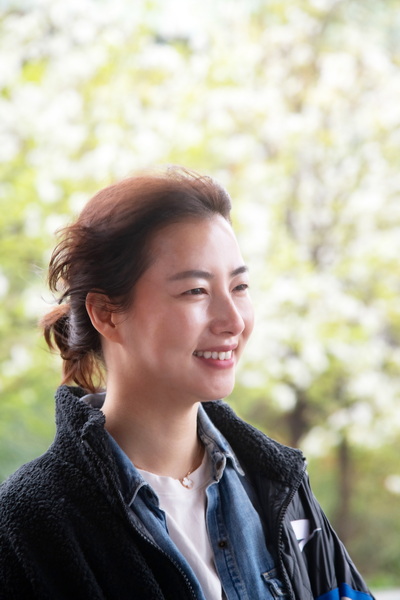
Jennis: Thank you for making time for this interview. After seeing your artworks at the Gwangju International Art Fair, I became curious about how you came to embrace the theme of women in your works. I would love to hear your art story.
Kim Mi-ae: I majored in art education at Chonnam National University. Having liked painting since I was young, I wanted to make a career out of painting. But my parents, who were school teachers, wanted me to be a teacher like them. My parents suggested that painting would still be possible as an art teacher. So, I majored in art education, following my parents’ wishes. However, while attending school, the Department of Art Education was changed into the Department of Art Theory in the College of Art. I remember that I joined in protesting the school’s policy with my fellow students. After graduating from university, I became a reporter at a broadcasting company, instead of becoming an art teacher.
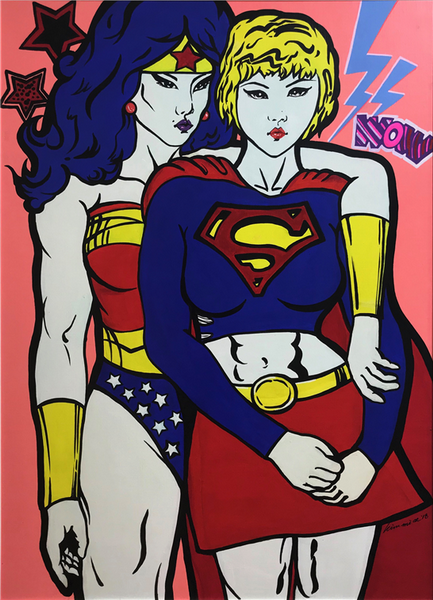
Jennis: Why did you decide to become a reporter?
Kim Mi-ae: I had a great opportunity when I was a university senior. A professor, who taught us Western art history, recommended me to participate in a program promoting the Gwangju Biennale. In the program, I had the assignment of interviewing an art director named Jemma Han. That experience served as an opportunity to become a reporter for a TV program introducing restaurants and festivals in Gwangju and Jeollanam-do. But as you know, an interviewer should approach interviewees and ask a lot of questions. This was hard for an introvert like me. So, I quit the job and decided to do the master’s and doctoral programs at the Korea National University of Education. I wanted to study art education beyond the little I had received as an undergraduate student.
Jennis: So, you were able to learn how to teach art at last.
Kim Mi-ae: Yes, it was a time to realize the importance of art education again. And at that time, I also discovered my desire to create art. I appreciate Professor Choi Chul, who helped me to realize that I had the dream of becoming an artist. However, in the back of my mind, I was still not sure about my ability as an artist because I was majoring in art education, not fine arts.
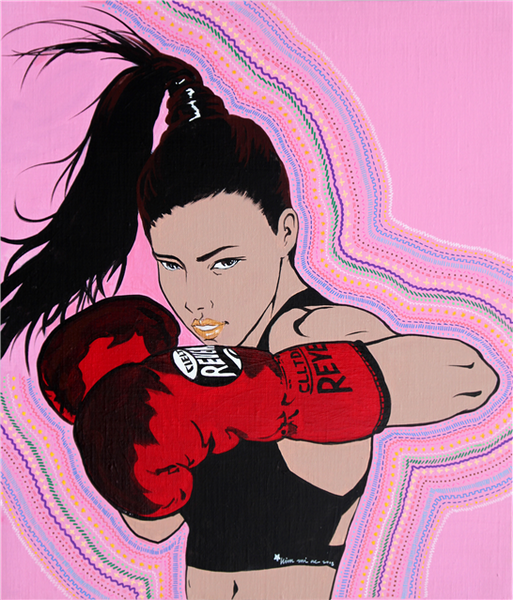
Jennis: It has been said that conceptual art that captures the artist’s thought is the essence of modern art. My niece, who studied fine art in France, told me that in France art college students are not required to be good at art to gain admission. Students there grow into being artists by discussing philosophical, historical, and cultural contents. That might be why I am so interested in your artworks. I wonder whether there is a particular reason for you to paint on the subject of women. What would you like to convey through your art?
Kim Mi-ae: People say, “The most personal thing is the most creative one.” With this, I agree. I would like to tell my life-centered story through my art. I grew up in a very conservative family. My parents asked me to behave as a nice girl in order to be “a wise mother and good wife” (현모양처, 賢母良妻), and they placed me under a strict curfew. It was an unbearable restraint for a young girl who was living in the modern world outside home life. They did not even allow me independence before marriage. I love my parents, but in order to gain independence from their excessive affection, I decided to get married. The type of partner I was looking for was a man who could help me to stand on my own. Fortunately, my married life is going well with respect to the two of us, just as I had dreamt.
The times continue to change, and the conflict between the values I learned from my parents and the values I have felt in my present life is constantly confusing to me. But this confusion is surely not just mine. So, I wanted to express the story of women’s social status through self-portraits in my art.
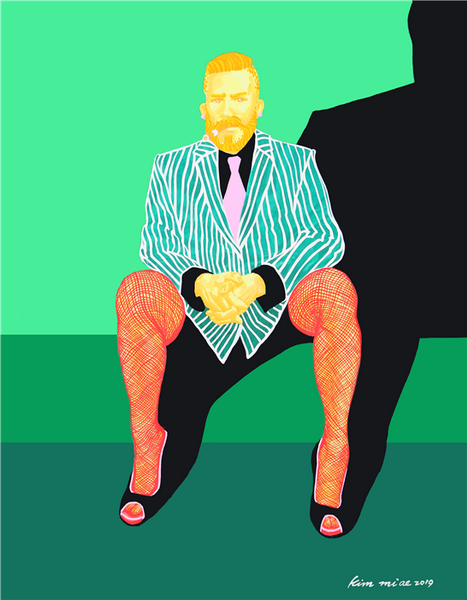
Jennis: Your painting of a man in heels and wearing stockings is quite intriguing. Ever since I first saw it, I have wanted to ask you what you wish to convey in that painting.
Kim Mi-ae: My painting tells the story of my parents, and it also contains the story of my husband. My husband is a delicate and quiet person. I think he is a person who has a lot of feminine aspects. Married couples seem to make up for the weak points in each other. I think my introverted husband needs a more active wife’s role. This has turned me into a more active woman.
We have been raised to believe that women should act feminine and men should be masculine. “Men don’t cry. Women should be meek and obedient” – like this, we have set women apart from men. But I have realized that I have some masculinity within me and that some men have feminine facets. In fact, the degree would depend only on the situation or context that each individual is in. What I wanted to do with that painting was bring out the inner man who has had to hide his feminine aspects from others. So, to do this, I combined the image of a strong man with some objects symbolizing femininity.

Jennis: You said that you would like to gain freedom from the eyes of those who measure women only from the appearance that the world dictates, but some women in your paintings still show beautiful feminine qualities, boldly revealing their sexuality.
Kim Mi-ae: I would love to freely express human beauty. However, since I am also a person who has been immersed in the ingrained customs and education of this society, there has been this inner dilemma in expressing human beauty. But this is my mission: to find the beauty in women as being strong, confident, and challenging. I think my art is in the process of breaking away from the long-held social perception engraved upon my body.
Jennis: Your artworks contain difficult themes. I wonder why you chose pop art as a medium for conveying your issues.
Kim Mi-ae: Pop artists such as Roy Lichtenstein [1923–1997], Andy Warhol [1928–1987], Jean Michel Basquiat [1960–1988], and Keith Haring [1958–1990] used thick outlines and speech bubbles to create a new sensation in painting, breaking with traditional art concepts. Just like these pop artists, I hope that my paintings expressing women in this society will raise questions and awareness in their viewers.
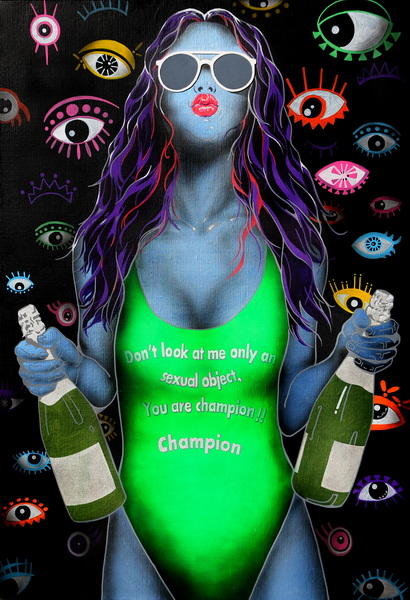
Jennis: When I was in college, ladies were not supposed to enter billiard halls, and a prevalent myth of the time was “With a woman in the boat, fish cannot be caught.” But these days, we often see older ladies driving tractors and trucks in the country. The world has changed a lot and change will continue. Viewing your artwork conjures up the dichotomy of masculinity and femininity that we have been all too familiar with for such a long time. I thank you for this extensive interview.
In Closing…
Artist Kim Mi-ae operates an art academy in Gwangju’s Ilgok-dong. She told me that she has more time now to devote to art due to COVID-19. Through her art, she asks what gender is, reminding me of a saying by the philosopher Ivan Illich: “Gender is in every step, in every gesture, not just between the legs.”
Select Exhibitions (Among 6 individual, 27 group)
2021 Gwangju International Art Fair, “Art Gwangju 21,” Kim Daejung Convention Center, Gwangju.
2021 “Would You Like Some Ramen?” Mino Gallery, Gwangju.
2021 Seoul International Art Fair, “World Road, K Art Road,” COEX, Seoul.
2021 Democratic Support Solidarity Exhibition with Myanmar Artists, Chonnam National University, Gwangju.
2020 The 6th Young Artist Exhibition, “Light Up,” Buk-gu Office Gallery, Gwangju.
2019 Art Gwangju 19, Kim Daejung Convention Center, Gwangju.
2019 Insa-dong Fair, Insa Art Center, Seoul.
2019 Art Busan, BEXCO, Busan.
2019 Seoul Art Expo, Personal Booth, COEX, Seoul.
2019 “Spirit of Art,” Korea Daily Art Center, Los Angeles, USA.
2018 Daejeon International Art Show, Trade Exhibition Hall, Daejeon.
2017 Seoul Art Show, COEX, Seoul.
Award
Grand Prize: The 15th Ansan International Art Fair
Photographs courtesy of Kim Mi-ae.
The Interviewer
Kang Jennis Hyunsuk has been living in Gwangju all her life. She has painted as a hobby for almost a decade, and she has learned that there are so many wonderful artists in Korea. As a freelance interpreter, she would like to introduce the English-speaking world to the diverse sphere of Korean art. Instagram @jenniskang







